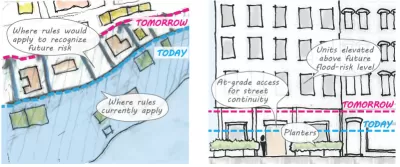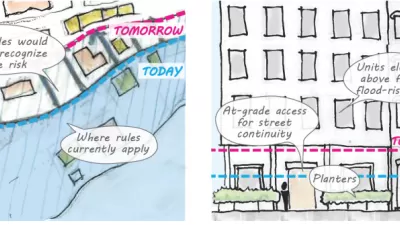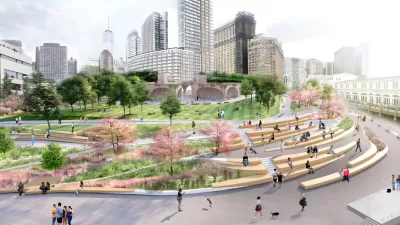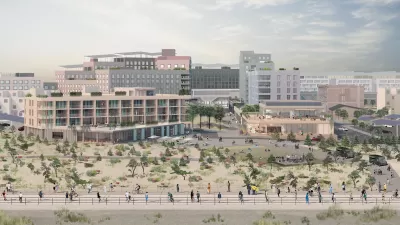Emergency responses to Hurricane Sandy have turned into long-term lessons in New York City, as the nation's largest city crafts a response to sea-level rise and extreme weather by making changes to the zoning code of coastal areas.

"The City Planning Commission (CPC) approved citywide zoning rules to protect coastal areas from flooding and sea level rise in a committee vote Wednesday," reports Chava Gourarie.
The new Zoning for Coastal Flood Resiliency (ZCFR) rules, detailed in an October 2020 Planetizen post, "would affect homes and buildings in areas designated as floodplains to ensure that they can withstand storms and other disasters, as well as recover from them quicker," explains Gourarie.
More specifically, according to Gourarie:
The proposed plan would allow existing homeowners and property owners to add resiliency measures, such as moving equipment to higher ground or elevating their structures. The new rules would allow more flexible zoning on new construction, introduce recovery measures that would be triggered by emergencies, expand the area eligible for the new zoning regulations, and restrict the number of new nursing homes built in flood zones.
If approved by the New York City Council, the zoning changes would permanently enshrine zoning changes implemented as an emergency measure after Hurricane Sandy.
More new coverage, by Mark Hallum, is available from AM New York. A press release from the New York City Department of City Planning includes soundbites on the approval from New York City Planning Commission Chair Marissa Lago.
FULL STORY: City Planning Commission Approves Citywide Coastal Zoning Rules

Study: Maui’s Plan to Convert Vacation Rentals to Long-Term Housing Could Cause Nearly $1 Billion Economic Loss
The plan would reduce visitor accommodation by 25,% resulting in 1,900 jobs lost.

North Texas Transit Leaders Tout Benefits of TOD for Growing Region
At a summit focused on transit-oriented development, policymakers discussed how North Texas’ expanded light rail system can serve as a tool for economic growth.

Using Old Oil and Gas Wells for Green Energy Storage
Penn State researchers have found that repurposing abandoned oil and gas wells for geothermal-assisted compressed-air energy storage can boost efficiency, reduce environmental risks, and support clean energy and job transitions.

Private Donations Propel Early Restoration of Palisades Playground
Los Angeles has secured over $1.3 million in private funding to restore the Pacific Palisades playground months ahead of schedule, creating a modern, accessible space that supports community healing after recent wildfires.

From Blight to Benefit: Early Results From California’s Equitable Cleanup Program
The Equitable Community Revitalization Grant (ECRG) program is reshaping brownfield redevelopment by prioritizing projects in low-income and environmental justice communities, emphasizing equity, transparency, and community benefits.

Planting Relief: Tackling Las Vegas Heat One Tree at a Time
Nevada Plants, a Las Vegas-based nonprofit, is combating the city’s extreme urban heat by giving away trees to residents in underserved neighborhoods, promoting shade, sustainability, and community health.
Urban Design for Planners 1: Software Tools
This six-course series explores essential urban design concepts using open source software and equips planners with the tools they need to participate fully in the urban design process.
Planning for Universal Design
Learn the tools for implementing Universal Design in planning regulations.
Ascent Environmental
Borough of Carlisle
Institute for Housing and Urban Development Studies (IHS)
City of Grandview
Harvard GSD Executive Education
Toledo-Lucas County Plan Commissions
Salt Lake City
NYU Wagner Graduate School of Public Service





























